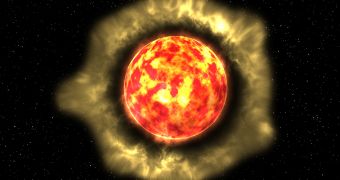In a paper published in the April 12 issue of the top scientific journal Nature, experts propose a new explanation for how stars of moderate weight manage to shed more than half of their mass, as they reach the end of their burning cycle.
What researchers observed when surveying medium-weight stars was that the objects tended to part away with the outer layers of their atmospheres before their deaths. Exactly how this happened had remained a mystery for a long time, but the new study provides a plausible explanation for the phenomenon.
In a series of new observations, scientists determined that dust grains located in the outer layers of stars' atmospheres tended to increase in size to surprising dimensions. This growth process is what allows dust to deflect significant amounts of light, which then moves high amounts of mass to space.
Studies such as this one are extremely important for our understanding of how the earliest stars and galaxies appeared and developed. In addition, it is known that all chemical elements heavier than hydrogen and helium were produced inside stars.
When these objects shed their atmospheres, or blast in powerful supernova explosions, they spread these chemicals inside molecular clouds or stellar nurseries, seeding them into the next generation of stars. In time, heavier and heavier elements develop.
Astrophysicists believe that this is how chemicals including carbon and oxygen developed. The process occurred within the core of stars, where nuclear fusion turns the hydrogen isotopes deuterium and tritium into helium and a lot of energy.
“We wanted to know, how does it happen, how does the star eject most of its mass into the interstellar medium? We were trying to look very close to the star to see what is the engine pushing all this matter out?” says Observatoire de Paris astronomer Sylvestre Lacour, a member of the research team.
He explains that investigators found sand grains about 300 nanometers across within the outer layers of stellar atmospheres. “We found there's lots of dust, much more than we expected. It looks like the grains are transparent enough so they are not destroyed, but they deviate the light,” Lacour says.
The most important discovery made in this research is that it's not photons that push the dust grains away from stars. “The grain is pushed because it deviates the light and through this deviation there's some transfer of energy that pushes it away. That's how the grain can survive,” he adds.
The research was carried out using the European Southern Observatory's (ESO) Very Large Telescope (VLT), in Chile. The study team was led by University of Sydney expert Barnaby Norris, Space reports.

 14 DAY TRIAL //
14 DAY TRIAL //